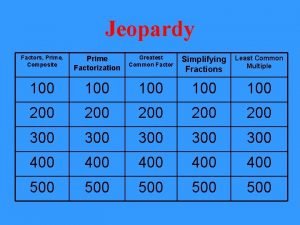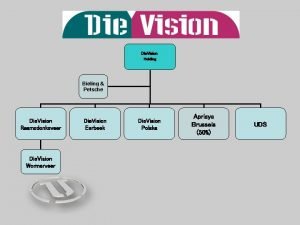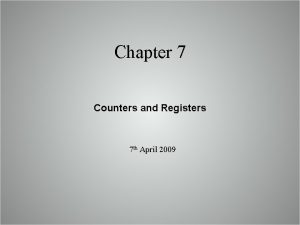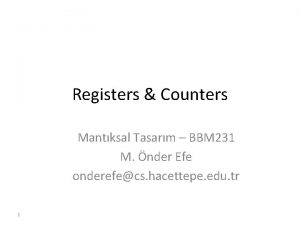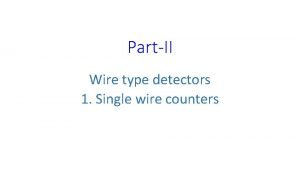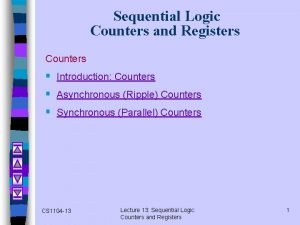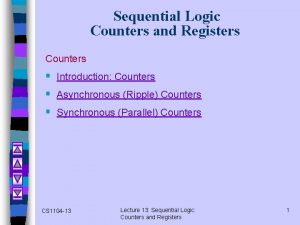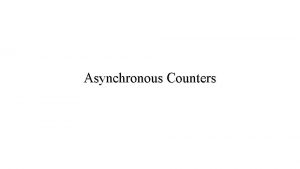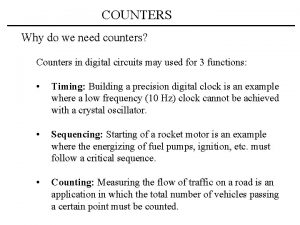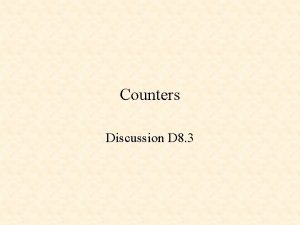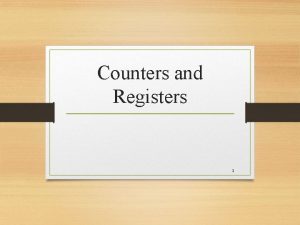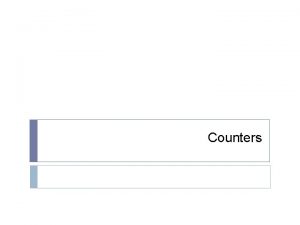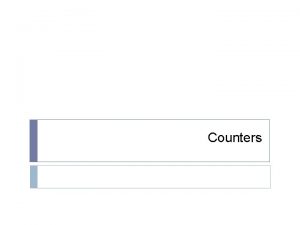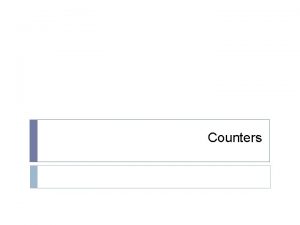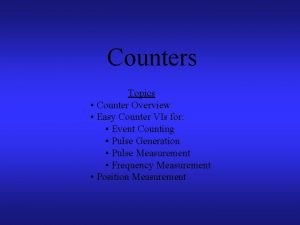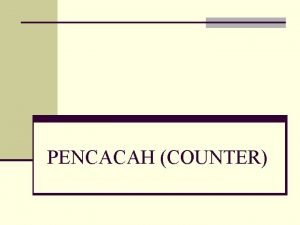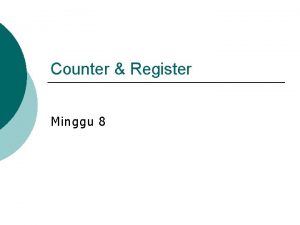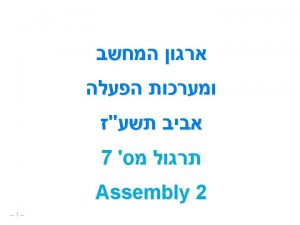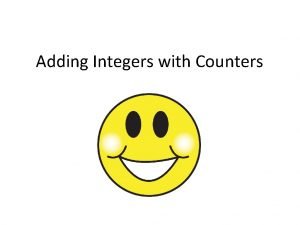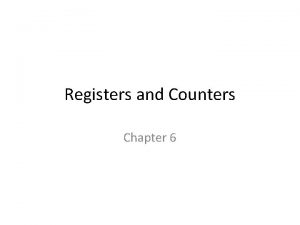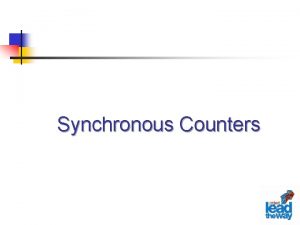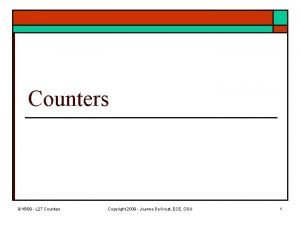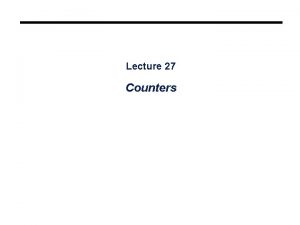Counter Instruction S 7 300 Mechanical counters Mechanical






















- Slides: 22

Counter Instruction S 7 300

Mechanical counters • Mechanical counters can serve the same function as programmed counters • Every time the actuating lever is moved over, the counter adds one number; the actuating lever then returns automatically to its original position • Resetting to zero is done with a pushbutton located on the side of the unit Mechanical counter

Electronic counters • Electronic counters can count up, count down, or be combined to count up and down • Although the majority of counters used in industry are upcounters, numerous applications require the implementation of down-counters or of combination up/ down-counters Electronic counters

Electronic counters • All PLC manufacturers offer some form of counter instruction as part of their instruction set • One common counter application is keeping track of the number of items moving past a given point Counter application

Counter Instructions • The following counter instructions are available: • S_CUD Up-Down Counter • S_CD Down Counter • S_CU Up Counter • ---( SC ) Set Counter Coil • ---( CU ) Up Counter Coil • ---( CD ) Down Counter Coil

Location of a Counter in Memory • Counters have an area reserved for them in the memory of CPU • This memory area reserves one 16 -bit word for each counter address • The ladder logic instruction set supports 256 counters • The counter instructions are the only functions that have access to the counter memory area

Setting count value • Bits 0 through 11 of the counter word contain the count value in binary code. The range of the count value is 0 to 999 • A preset value should be entered in in the format: C#127

S_CUD Up-Down Counter • A positive edge transition at input S of the Up-Down Counter instruction sets the counter with the value at the Preset Value (PV) input • A signal state of 1 at input R resets the counter. Resetting the counter places the value of the count at 0 • The counter is incremented by 1 if the signal state at input CU changes from 0 to 1 and the value of the counter is less than 999 • The counter is decremented by 1 if the signal state at input CD changes from 0 to 1 and the value of the counter is more than 0 • If there is a positive edge at both count inputs, both operations are executed and the count remains the same

S_CUD Up-Down Counter

S_CUD Up-Down Counter: Example

S_CU Up Counter • A positive edge transition at input S of the Up Counter instruction sets the counter with the value at the Preset Value (PV) input • With a positive edge, the counter is reset at input R. The resetting of the counter sets the count value to 0 • With a positive edge, the value of the counter at input CU is increased by 1 when the count value is less than 999 • A signal state check for 1 at output Q produces a result of 1 when the count is greater than 0; the check produces a result of 0 when the count is equal to 0

S_CU Up Counter

S_CU Up Counter: Example

S_CU Up Counter: Example • This control application is designed to turn the red pilot light on and the green pilot light off after an accumulated count of 7 Simple up-counter program

S_CU Up Counter: Example Timing diagram

S_CU Up Counter: Example

S_CD Down Counter • A positive edge transition at input S of the Down Counter instruction sets the counter with the value at the Preset Value (PV) input • With a positive edge, the counter is reset at input R. The resetting of the counter sets the count value to 0 • With a positive edge, the value of the counter at the input is reduced by 1 when the count value is greater than 0 • A signal state check for 1 at output Q produces a result of 1 when the count is greater than 0; the check produces a result of 0 when the count is equal to 0

S_CD Down Counter

S_CD Down Counter

Counter instruction: ---( SC ) Set Counter Value • Set Counter Value executes only if there is a positive edge in RLO. At that time, the preset value transferred into the specified counter

Counter instruction: ---( CU ) Up Counter Coil • Up Counter Coil increments the value of the specified counter by one if there is a positive edge in the RLO and the value of the counter is less than "999“ • If there is no positive edge in the RLO or the counter already has the value "999", the value of the counter will be unchanged

Counter instruction: ---( CD ) Down Counter Coil • Down Counter Coil decrements the value of the specified counter by one, if there is a positive edge in the RLO state and the value of the counter is more than "0“ • If there is no positive edge in the RLO or the counter has already the value "0", the value of the counter will be unchanged
 300 300 400
300 300 400 200 300 300
200 300 300 300 + 300 + 400
300 + 300 + 400 300 + 200 + 200
300 + 200 + 200 300 square root
300 square root 100 + 200 + 300
100 + 200 + 300 300+300+400
300+300+400 Is 33 prime or composite?
Is 33 prime or composite? 200 + 200 + 300
200 + 200 + 300 300+300+400
300+300+400 400 + 300 + 300
400 + 300 + 300 200+200+300+300
200+200+300+300 300+300+400
300+300+400 The plc counter instruction is similar to the
The plc counter instruction is similar to the § 367 abgb
§ 367 abgb Individualized instruction vs differentiated instruction
Individualized instruction vs differentiated instruction Coe 202
Coe 202 Pertinax counters
Pertinax counters Etools counters
Etools counters Mathsbot counters
Mathsbot counters Mod 60 counter
Mod 60 counter Bbm231
Bbm231 Wire counters
Wire counters







